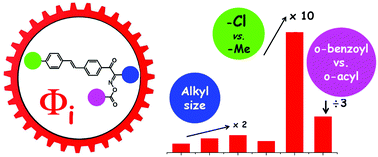Substituted stilbene-based oxime esters used as highly reactive wavelength-dependent photoinitiators for LED photopolymerization†
Abstract
Six novel oxime carboxylate photoinitiators were designed on the basis of a π-conjugated (E)-1-(4-styrylphenyl)-1-one subunit. Different substituent groups were introduced into three distinctive sites of the chromophore to rationalize their related electronic and structural effects on free-radical photoinitiating reactivities. The electronic properties, photodissociation mechanism, and structure–reactivity relationships were investigated by UV–visible spectroscopy, DFT calculations, real-time 1H NMR, electron spin resonance spectroscopy, and photo-DSC. We demonstrate that the structural change affecting the photoinitiating properties corresponds to a para-substitution effect on the stilbene subunit using an electron-acceptor group. Such a structural change leads to a 10-fold enhancement in initiation efficiency (Φi) upon visible irradiation of light-emitting diodes. The photoinitiating performances of these new derivatives are strikingly sensitive to the excitation wavelengths, leading to an impressive enhancement of Φi by more than three orders of magnitude from 365 nm to 405 nm irradiation. This wavelength-dependent reactivity previously observed for commercially available oxime esters can be generalized in our series and has high potential photocuring applications in low-power visible LEDs.



 Please wait while we load your content...
Please wait while we load your content...